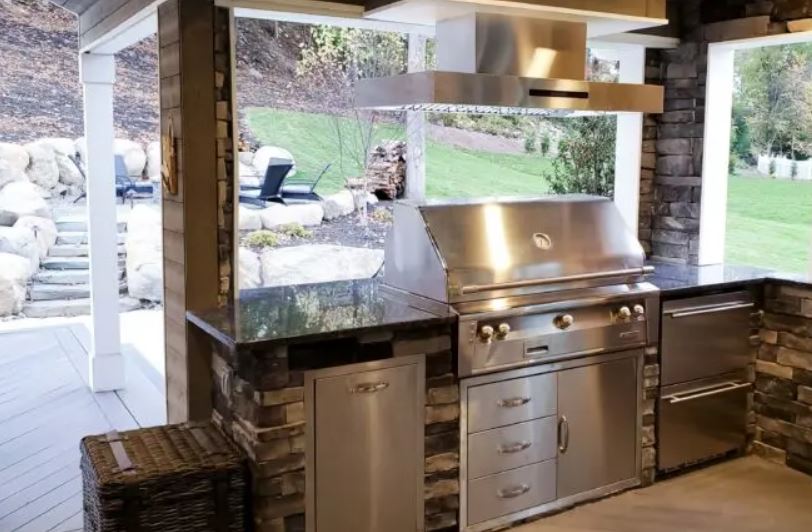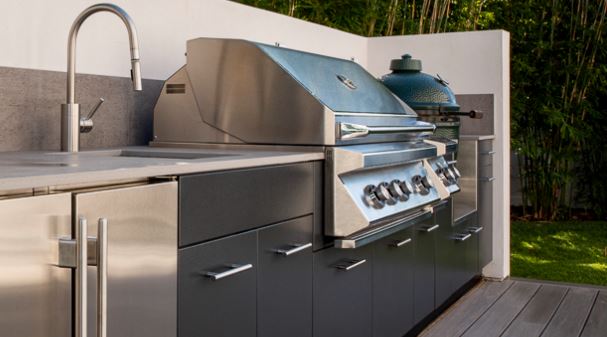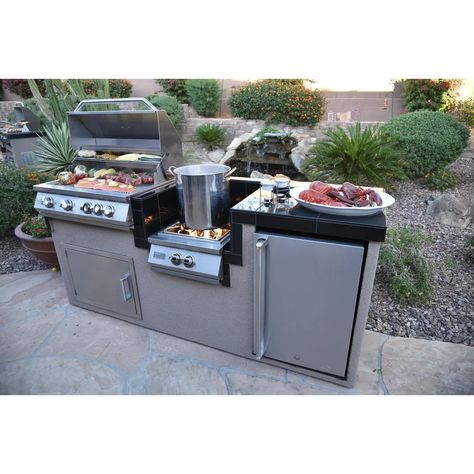How to Vent an Outdoor Kitchen
Venting an Outdoor Kitchen
You might be in the great outdoors, but you still need to consider ventilation for your outdoor kitchen and barbeque grills.
There are two types of outdoor kitchen ventilation. One is for the smoke and fumes from outdoor cooking. The second is ventilation for your cabinetry.
In this post, we will discuss the two types of ventilation you need for your outside kitchen and why they are important to incorporate in your outdoor kitchen design.
Outdoor Kitchen Ventilation Hood
Choosing a vent hood for your outdoor kitchen differs from selecting one for your interior kitchen. These hoods have been specially designed to resist the heat and dampness of the outdoors.
If your outdoor kitchen is covered, you will need a vent hood. Some municipalities require vent hoods for outdoor grills and other cooking devices so you should check local building codes for the regulations.
You might ask yourself if you really do need ventilation for your grill. The answer is yes.
You should install a vent hood to manage grease and smoke when your grilling setup is employed beneath an enclosed or even semi-enclosed overhead structure. A vent hood can also help to manage smoke that might otherwise get into other areas of your outdoor kitchen, causing your guests to be disturbed.
Continuous grilling on a cooking device set against an exterior wall will cause streaks and marks on the wall from the smoke if not vented properly, in addition to avoiding smoke build-up. Protect your investment in your home and outdoor kitchen by getting a vent hood.
Locating your grill or cooking appliance at the edges of your property might alleviate the smoke and odors that drift onto your patio dining area. But what about the prevailing winds that might take that smoke right onto your neighbor’s pool deck? This is a factor to consider when deciding where to locate your outdoor kitchen and how you will manage the grill smoke, whether your kitchen is covered, partially covered or entirely open air.
What should I be on the lookout for?
Outdoor vent hoods are available in a variety of configurations, ranging from internal blower speed to CFMs. Because it’s not always easy to decipher all of the lingo, we’ve put together some tips to assist you in finding the appropriate item.
It’s All About the Size
Choose a vent hood exhaust fan that is larger than your grilling area to catch the smoke on a windy day. This will prevent smoke from accumulating around the vent hood and escaping. The majority of barbecue manufacturers recommend a minimum size. You can follow their specifications, but you should avoid selecting a hood that is smaller than what the manufacturer suggests. The minimum that is typically recommended is 4 to 6 inches larger than your grill size but no less than 36″ deep.
What exactly are CFMs?
The number of cubic feet per minute (CFM) indicates how much air a fan pushes. Because it must withstand wind speed and the smoke produced by your grill, it’s critical to choose a strong fan for your outdoor kitchen. The fan on hoods with a greater CFM rating is more powerful. A hood with a minimum of 1200 CFMs is recommended, but you won’t be disappointed if you go with something more powerful for an outdoor kitchen as some models will produce up to 2000 CFMs.
Indoor hood vents just do not exhaust enough CFMs to deal with the amount of smoke that gas grills, wood fire and charcoal grill produce. Range hoods produce 300 CFMs on average, clearly not enough for smoke removal from a smoky grill.
Blower Speeds
Many ventilators include changeable internal blower speeds, allowing your vent hood to adapt to changing weather, wind speeds, and smoke levels. If you have changeable winds or want additional flexibility with your ventilation system, look for this option. This feature isn’t essential, however depending on your tastes, it may be useful.
Airflow and the roof cap
Decide if you’ll vent the smoke through a roof vent or an outside wall before purchasing a vent hood. If you’re not sure which choice is ideal for your setup, see an expert. Roof top vents are normally a more direct route to let air out, but for an outdoor kitchen, an outside wall might be a better solution.
Putting the hood in the right place
From the base of the counter to the base of the hood, we recommend a distance of 36”. You don’t want it to be too high, or the smoke won’t be captured. You’ll be hitting your head if it’s too low.
Sizes of Vents
If you’re cooking outside, the size of the vent is crucial. It won’t catch enough smoke if it’s too small. Choose a vent with a diameter of at least 10 inches. You might want to search for multiple vents or other features that enhance the total vent space on larger grills.
Roof vent or exterior wall?
From the base of the counter to the base of the hood, we recommend a distance of 36”. You don’t want it to be too high, or the smoke won’t be captured. You’ll be hitting your head if it’s too low.
Outdoor Kitchen Cabinet or Island Gas Vent Panels
Outdoor kitchens and custom-built BBQ islands have been a popular addition to the outdoor/backyard eating scene in recent years. Outdoor kitchen islands, unsurprisingly, provide a fantastic opportunity to transport your indoor dining experience to your backyard patio and enjoy an exquisite and enjoyable time with your family and friends.
While outdoor kitchens can be a wonderful way to spend time with family and friends, they can also become dangerous buildings in your backyard if they are not properly ventilated.
A structure for an outdoor kitchen is no different than any other setting or structure that uses gas equipment. It simply has to be ventilated since trapped gases can produce an explosion, which can result in serious injuries or even death if not properly ventilated. Statistics have pointed to an alarming trend in safety-related accidents caused by incorrectly constructed bbq grill islands over the last few years. Each of these mishaps could have been avoided with an island vent or strategically placed stainless steel vents in your outdoor kitchen counters.
Propane gas is heavier than oxygen by nature, making it more likely to gather in areas where there is no airflow such as the cabinet where you store your propane tanks. Despite being lighter than oxygen, natural gas can accumulate. Because these gases can and can collect in restricted spaces, it’s critical that an outdoor kitchen be properly ventilated to allow them to escape.
Unfortunately, when it comes to creating an outdoor kitchen, there are currently no specific standards that address venting. When you mix a neglected grill, an accumulation of excess garbage, grease, and carbonized food particles, and an outdoor kitchen structure that hasn’t been ventilated, you have a nightmarish scenario. You can envision the horrific possibilities that could play out if the debris catches fire and gas has gathered under the grill counter.
How Many Vents do you need for an outdoor kitchen or bbq island?
As there are no regulations regarding outdoor cabinet ventilation as of yet, a rule of thumb is to make sure your cabinetry is vented with stainless steel vents every 4 feet. If your fuel type is natural gas, then you will want to place the vents at the top of the cabinetry as high as possible. If you use propane, then the vents should be situated as low as will fit in the cabinets.
Don’t underestimate the importance of ventilation. While the vent hood may seem optional and a way to save money, the cost of installing one after the outdoor kitchen is complete is several thousand dollars — substantially more than if you had done so from the start.
photo: Proline







